Valdez
Above 4,000ftModerate
2,000 to 4,000ftModerate
Below 2,000ftModerate
Degrees of Avalanche Danger
Avalanche Problems
Problem 1
Surface Hoar was buried 1/3 in specific locations by 6-15 inches of snow, 15 near the coast and less so as you move interior from the pass. The distribution of this layer will be important in the coming days/weeks. The mid elevation band (2-4000′) north of Thompson Pass is where this layer is the most prominent, but has also been reported as far south as Snow Slide Gulch at mid elevations. Gullies and shaded/protected terrain will also likely harbor buried surface hoar. Most reports from 12/31-1/2 indicated that SH went away in upper elevation start zones, but may exist in some places.
At this point the new snow that arrived 1/3 is uncohesive and/or not enough to overburden this layer except in steep convex terrain were human triggered avalanches will be possible. This situation will change in the coming days as the new becomes a cohesive slab by means of: settlement with time, wind transported snow and/or additional snowfall.
Public observations will be important in the coming days.
Likelihood:
- Almost Certain
- Very Likely
- Likely
- Possible
- Unlikely
Size:
- Historic
- Very Large
- Large
- Small
Trend
- Increasing
- Steady
- Decreasing
Problem 2
Northeast winds are forecasted to kick up on Thompson Pass with gusts up to 40 mph. This will easily redistribute the new low density snow where the wind is present. Wind slabs up to 2 feet deep may form that will be reactive to human triggers. Watch for signs of wind transported snow including damaged snow surfaces and pillowed snow. Shooting cracks are always a clear indication of unstable snow.
Likelihood:
- Almost Certain
- Very Likely
- Likely
- Possible
- Unlikely
Size:
- Historic
- Very Large
- Large
- Small
Trend
- Increasing
- Steady
- Decreasing
Avalanche Activity
12/24- Observers reported remote triggered avalanches up to 100 meters away that were a meter deep. Tsaina trees below 3000′.
12/23- DOT mitigation work on snow slide gulch produced 3 D2.5’s that ran half of their path.
– HS-N-R3-D3-G, NW Crudbusters/ ~5000′
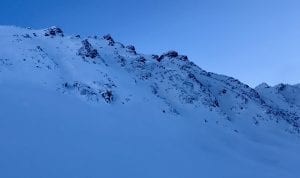
-Multiple D2-D2.5 slides on Oddessey and Little Oddessey. NW-N aspects. Only Little Oddessey crown was clear. ~100 yards wide, ~4′ deep.
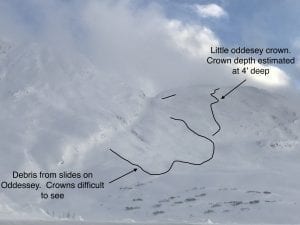
-Natural D3 avalanche on Billy Mitchell NW-N aspects, originated ~5000′ stepped down to the ground around 4200′ in rocky terrain. Approximately 200 yards wide.
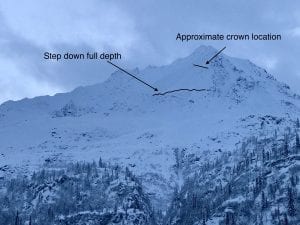
-Natural D2 avalanche activity was also noted on west aspects of 40.5 mile and Iguana Backs ~3500′. Further observations were prevented due to poor light.
12/20- A powder cloud reached the highway at the mp 42 slide path. “Three Pigs”. No other details available
-Numerous small (3-4″ deep) natural avalanches were observed in the Python and Cracked Ice Buttress area.
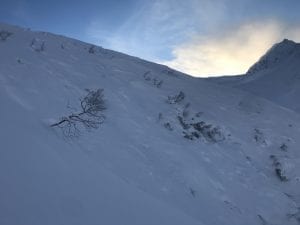
12/20- Multiple D1 soft slabs off Mt Cheddar Cheese Wedge (Hippie Ridge) originating from ~6500′
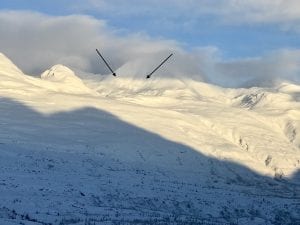
12/3- Numerous natural avalanches were observed north of Thompson Pass with many avalanches failing at the ground. Observations were not made south of Thompson Pass.
Avalanches observed from 46 mile towards Thompson Pass:
Three Pigs: Nearly every path on the SE face ran with debris deposits stopping in the top 1/3 of aprons, thick alders prevented slides from running full path. These were mostly D3 avalanches.
40.5 Mile Peak: Many paths running similar to Three Pigs, with one running full path to the Tsaina river. Mainly W-NW aspects, D3’s
Max High (Peak on the southern extent of Hippie Ridge) had a D3 avalanche with a crown near 5500′,SW aspect.
Upper Catchers Mitt bowl E aspect, slid R4-D3 ,triggering further avalanches lower down.
The main activity noted, was on the buttresses on the east side of the pass, from Cracked Ice through North Odessey Gully. Every buttress had significant avalanche activity originating ~4000-5000′. Many of these failed at the ground, north – northwest aspect. Pictures below.
School Bus and North Odyssey Gully both ran with debris in the runouts.
Many other large to very large natural avalanches occurred.




12/2- DOT reported a natural D2.5-3 avalanche that hit the Lowe river at Snowslide Gulch.
11/30- Natural avalanche observed on 40.5 mile peak just to the South of the Shovel. West aspect, ~4500′, crown ~200′ wide, poor light prevented further observation. SS-N-R1-D2-U.
11/29: Natural avalanche observed on Billy Mitchell Cry babys shoulder, similar elevation as 11/16 slide but originated a couple hundred meters further west. Released from ~4000′ with a crown length of ~ 200 meters, North aspect, ~ 37°, failed at the ground. HS-N-R2-D2.5-G

11/16: Natural avalanche observed on Billy Mitchell “Cry babys shoulder”. Released from~3500′ with a crown length of ~200 meters, North aspect. This slide was triggered by recent NE wind cross loading the slope. SS-N-R2-D2-U
11/15: Natural avalanche observed in Loveland Basin on a South aspect, down the ridge from Tones Temple. This slide was triggered by recent NE wind loading and failed at the ground. SS-N-R1-D2-G
Weather
01/05- Light to moderate northeast wind with gradually clearing skies.
The Thompson Pass Mountain Forecast covers the mountains (above
1000 ft) surrounding Keystone Canyon through Thompson Pass to
Worthington Glacier.
This forecast is for use in snow safety activities and emergency
management.
Today Tonight
Temp at 1000` 23 F 11-17 F
Temp at 3000` 17-26 F 19 F
Chance of precip 0% 50%
Precip amount
(above 1000 FT) 0.00 in 0.02 in
Snow amount
(above 1000 FT) 0 in trace
Snow level sea level sea level
Wind 3000` ridges NE 22-36 mph NE 22-38 mph
Remarks...None.
| Date: 01/05 | 24 hr snow (inches) | HN24W (snow water equivalent inches) | High Temp (F) | Low Temp (F) | Weekly SWE Inches (Monday-Sunday) | January snowfall | Season snowfall | HS (snowpack depth inches) |
| Valdez | Trace | 0 | 28 | 19 | .95 | 15 | 112 | 53 |
| Thompson Pass | N/O | N/O | 24 | 3 | .9 | 11 | 258 | 66 |
| 46 Mile | 0 | 0 | 3 | -10 | .24 | 3 | 77 | 33 |
Thompson Pass weather history 20/21. Click on links above the images to see full size view
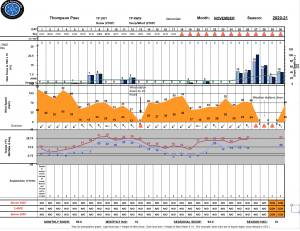

Additional Information
12/31-1/2- Clear weather with light winds has allowed surface hoar to grow on the north side of Thompson Pass. Crystals up to 1 cm were observed on Crudbusters 1/1 up to ridge tops. This layer has been buried by 6-15 inches of snow 1/3, and now exists as a weak layer in our snowpack in specific locations. Being able to map the distribution of this layer through our range will be important in the coming week. If you see Buried Surface Hoar, leave a public observation indicating what elevation you observed it.
12/24-12/30- Generally benign weather with light snowfall and light to moderate winds has allowed our snowpack to gain strength. Last reported avalanche activity was 12/24.
12/21-12/23- Major winter storm brings strong winds, increasing temperatures and 36″ of snow and 3.35″ of SWE to Thompson Pass at road level.
12/19-12/20- Continued stormy weather incrementally deposits ~12 inches of low density snow. Top 3-4 inches doesn’t bond well to underlying snow and is reactive on 12/20 in multiple locations.
12/17-12/18- Significant north winds along with light snow has built wind slabs on lee aspects. These slabs may be sitting on persistent grains such as near surface facets in some locations.
12/13-12/16- Light snow has been falling and has landed on surface hoar below 3000′. This layer exists north and possibly south of Thompson Pass. On Thompson Pass proper, buried surface hoar is unlikely due to wind. So far there is an insignificant amount of snow to overload these layers and create dangerous conditions. This will be a layer to watch below 3000′ once more snow accumulates, possibly by this weekend. If you have observed surface hoar in the Port of Valdez area leave an observation.
12/8-12/12- Clear cold and calm was the theme during this period. With this, surface hoar has begun to form below 3000′. On 12/12 surface hoar was found to exist up to 1.5 cm in length on flat benches. On slopes the size was 2-4 mm. SH has not been observed in high elevation start zones. If conditions remain calm before the next snowfall this will form a sensitive layer in our snowpack in our low and mid elevation bands.

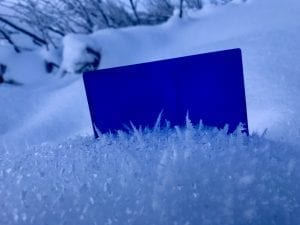
12/5-12/7- Thompson Pass received 23 inches of snow with 2.23″ of SWE. Temperatures and freezing line rose mid storm bringing rain to the coast.
NE winds began 12/4 and have redistributed the storm snow onto lee aspects. This wind event has not been widespread and appears to be concentrated to areas in close proximity to Thompson Pass.
November was mostly dominated by clear, cold and windy weather. On 11/25 a major wx pattern shift occurred which produced 8 days of consecutive storms that delivered 10 inches of water and 90″ of snow to Thompson Pass. This storm fell on a thin snowpack with poor structure near the ground. On 12/1-12/2 a widespread natural avalanche cycle occurred with many avalanches failing at the ground. This event was caused by 4.6″ of SWE on Thompson Pass in a 72 hour period along with rising temperatures bringing the freezing line up to 3000′.
Announcements
The avalanche hazard is moderate at all elevations. Triggering a persistent slab avalanche 6-18 inches deep will be possible 1/5. New snow amounts from 1/3 range from 15 inches near the coast to 6 inches at the northern extent of our forecast area. This new snow has fallen on facets in some locations. Watch for signs of instability like shooting cracks or collapsing. Avoid steep convex slopes, terrain traps and areas that are receiving active wind loading.
For more information click the (+full forecast) button below.
Submit a public observation to help create a picture of our constantly changing snowpack. Visit our observation page to leave a comment or you can email me directly at [email protected].

